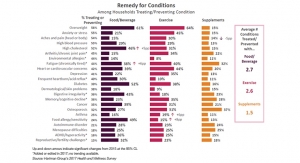03.15.19
A study has found that vitamin D may be protective among asthmatic obese children living in urban environments with high indoor air pollution. The study out of Johns Hopkins University School of Medicine, funded by the National Institute of Environmental Health Sciences (NIEHS), part of the National Institutes of Health, was published in The Journal of Allergy and Clinical Immunology: In Practice.
“The research team has identified many factors that make children susceptible to health problems from air pollution throughout Baltimore’s inner city,” said Kimberly Gray, PhD, administrator for the Children’s Environmental Health Research Centers program at NIEHS.
According to the Centers for Disease Control and Prevention, one in 12 children in the U.S. have asthma, which totals 6.1 million children nationally. Additionally, asthma disproportionately impacts urban minority populations, such as black children. Higher indoor air pollution, from sources such as cigarette smoke, cooking, burning of candles, and incense, is linked to greater respiratory problems, including worsening of asthma symptoms and more hospital visits.
“Asthma is an immune-mediated disease,” said Sonali Bose, MD, lead author of the study and assistant professor of medicine, pulmonary, critical care, and sleep medicine at the Icahn School of Medicine at Mount Sinai, and adjunct faculty at Johns Hopkins. “From previous scientific studies, we knew that vitamin D was a molecule that may influence asthma by impacting antioxidant or immune-related pathways.”
Bose explained that at the time the study was being conceived, researchers were seeing vitamin D deficiencies across the U.S. “It became very clear that African-Americans were at higher risk for vitamin D deficiency, particularly black children,” she said. “We were also noticing a heavy burden of asthma in inner city minority children. It seemed as though vitamin D deficiency and asthma were coincident and interacting in some way.”
The study tested three factors—air pollution levels in homes, blood vitamin D levels, and asthma symptoms—in 120 school-aged children with preexisting asthma in the Baltimore area. One-third of the study participants were also obese. The children were evaluated at the start of the study and three times over the next nine months.
Overall, they found that having low blood vitamin D levels was related to the harmful respiratory effects of indoor air pollution among obese children with asthma. Conversely, in homes that had the highest indoor air pollution, higher blood vitamin D levels were linked to fewer asthma symptoms in obese children.
“What surprised us the most was that the findings of the study showed the effects were most pronounced among obese children,” Bose said. “This highlights a third factor at play here—the obesity epidemic—and helps bring that risk to light when considering individual susceptibility to asthma.”
Bose said they will work to identify ways to increase blood vitamin D levels in these children, helping them be more resilient to environmental insults.
“One way to increase blood vitamin D levels is to increase sun exposure, but that isn’t always possible in urban environments, or in people with darker skin pigmentation,” she said. “Another way is through dietary supplements or eating more foods that are high in vitamin D, such as fatty fish, mushrooms, or foods fortified with vitamin D, such as bread, orange juice, or milk.”
Senior author Nadia Hansel, MD, director of the Division of Pulmonary and Critical Care Medicine at Johns Hopkins, added, “Another important take home point is how the complex environment comes together to contribute to extra burden of asthma in these low-income, urban communities. Our results suggest that improving the asthma burden in the community may require a multi-faceted approach.”
NIEHS and the U.S. Environmental Protection Agency jointly fund the collaborative NIEHS/EPA Children’s Environmental Health and Disease Prevention Research Centers, aimed at protecting children from environmental threats, reducing health risks, and promoting health and well-being.
“The research team has identified many factors that make children susceptible to health problems from air pollution throughout Baltimore’s inner city,” said Kimberly Gray, PhD, administrator for the Children’s Environmental Health Research Centers program at NIEHS.
According to the Centers for Disease Control and Prevention, one in 12 children in the U.S. have asthma, which totals 6.1 million children nationally. Additionally, asthma disproportionately impacts urban minority populations, such as black children. Higher indoor air pollution, from sources such as cigarette smoke, cooking, burning of candles, and incense, is linked to greater respiratory problems, including worsening of asthma symptoms and more hospital visits.
“Asthma is an immune-mediated disease,” said Sonali Bose, MD, lead author of the study and assistant professor of medicine, pulmonary, critical care, and sleep medicine at the Icahn School of Medicine at Mount Sinai, and adjunct faculty at Johns Hopkins. “From previous scientific studies, we knew that vitamin D was a molecule that may influence asthma by impacting antioxidant or immune-related pathways.”
Bose explained that at the time the study was being conceived, researchers were seeing vitamin D deficiencies across the U.S. “It became very clear that African-Americans were at higher risk for vitamin D deficiency, particularly black children,” she said. “We were also noticing a heavy burden of asthma in inner city minority children. It seemed as though vitamin D deficiency and asthma were coincident and interacting in some way.”
The study tested three factors—air pollution levels in homes, blood vitamin D levels, and asthma symptoms—in 120 school-aged children with preexisting asthma in the Baltimore area. One-third of the study participants were also obese. The children were evaluated at the start of the study and three times over the next nine months.
Overall, they found that having low blood vitamin D levels was related to the harmful respiratory effects of indoor air pollution among obese children with asthma. Conversely, in homes that had the highest indoor air pollution, higher blood vitamin D levels were linked to fewer asthma symptoms in obese children.
“What surprised us the most was that the findings of the study showed the effects were most pronounced among obese children,” Bose said. “This highlights a third factor at play here—the obesity epidemic—and helps bring that risk to light when considering individual susceptibility to asthma.”
Bose said they will work to identify ways to increase blood vitamin D levels in these children, helping them be more resilient to environmental insults.
“One way to increase blood vitamin D levels is to increase sun exposure, but that isn’t always possible in urban environments, or in people with darker skin pigmentation,” she said. “Another way is through dietary supplements or eating more foods that are high in vitamin D, such as fatty fish, mushrooms, or foods fortified with vitamin D, such as bread, orange juice, or milk.”
Senior author Nadia Hansel, MD, director of the Division of Pulmonary and Critical Care Medicine at Johns Hopkins, added, “Another important take home point is how the complex environment comes together to contribute to extra burden of asthma in these low-income, urban communities. Our results suggest that improving the asthma burden in the community may require a multi-faceted approach.”
NIEHS and the U.S. Environmental Protection Agency jointly fund the collaborative NIEHS/EPA Children’s Environmental Health and Disease Prevention Research Centers, aimed at protecting children from environmental threats, reducing health risks, and promoting health and well-being.



























